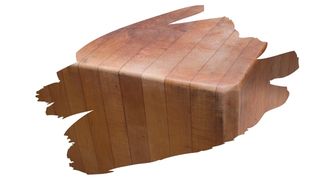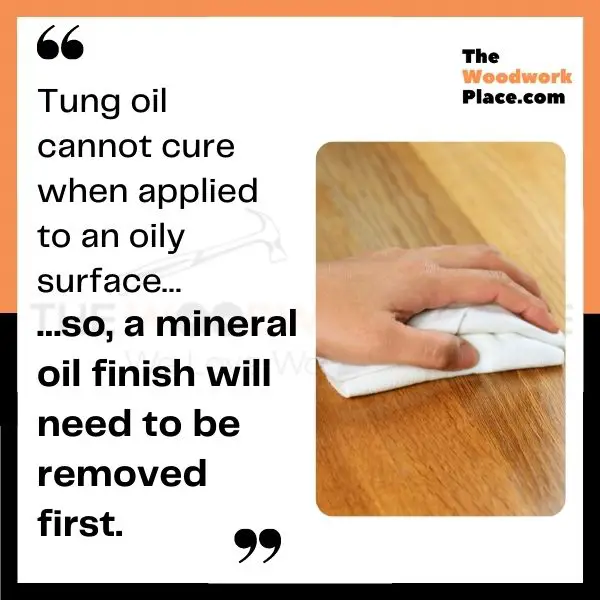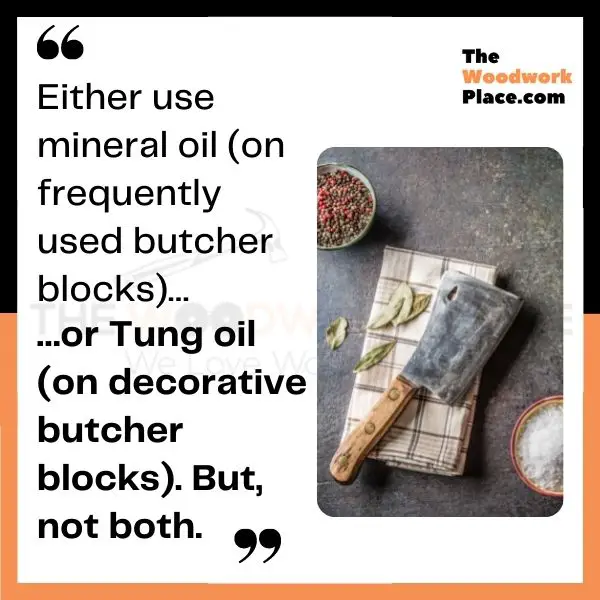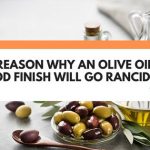You’ve just received the most beautifully crafted butcher block table. And now, (in order to keep it in tip top condition), you’re going to apply a quality wood finish.
So, of course, one of the best finishes for food prep surfaces (such as butcher blocks) is food grade mineral oil.
Related Post: Walnut Oil Vs Mineral Oil: Which One’s Better For Your Cutting Board?
However, if you want to keep that wooden surface hygienic, this non-drying oil needs to be reapplied frequently. And that may prove to be more maintenance than you’re willing to commit to.
And besides, there are plenty of other wood oil finishes that require less ongoing maintenance than mineral oil.
For example, pure Tung oil is a drying oil finish that works very much like mineral oil. It will penetrate wood grain, and make that butcher block timber more water resistant.
Yet, are these two oil finishes combined better than one? And will a Tung oil top coat stick and stay on over a mineral oil finish?
Well, in this post, you will learn why non-drying oils and drying oils rarely work well together. You will also find out what really goes into a Tung oil finish (hint: always check the label!)
And we reveal when (or whether) you should be using Tung oil or Mineral oil on that butcher block.

This post may contain affiliate links to products that we receive a commission for (at no additional cost to you). Learn more here.
First Off, What Is Mineral Oil?
Mineral oil is a bit of a special finish. That’s because it’s one of only a handful of non-drying oils that can be reliably used as a wood finish.
Other non-drying oils, (such as Sunflower Oil or Vegetable Oil), can go rancid. However, mineral oil will never decay or go off.
That’s because mineral oil is made from 100% petroleum, so this product never has an expiry date.
Now, when it comes to coating butcher blocks and cutting boards, only food grade mineral oil should be used.
While there are many different petroleum by-products, food grade mineral oil is made from highly refined petroleum distillate. And this refined version of mineral oil is so well filtered, that it is even safe for human consumption.
So Why Is Mineral Oil Such A Great Wood Finish?
Well, mineral oil is a non-drying oil that can soak into wood grain just like any other oil finish.
It will also coat wood fibers, just like any other finish. Which is key to preventing a wooden block from absorbing raw meat fluids and other liquids.
However, unlike other oil wood finishes, mineral oil will never dry—perpetually staying ‘oily’ to the touch.

Is Tung Oil The Same Thing As Mineral Oil?
Pure Tung oil is a very different finish from mineral oil.
Just like mineral oil, pure Tung oil is naturally sourced too. But, while mineral oil comes from out the ground, pure Tung oil comes from plants.
Tung oil is extracted from the seeds of Tung trees. And in its wood finishing form, this oil will dry and cure into a solid resin.
Basically, through the chemical process of polymerization, Tung oil will harden into a water-resistant resinous coat.
Pure Tung Oil: Why You Should Always Check The Label
Full disclosure, not all Tung oil products on the market are actually Tung oil. And, unless that product label reads ‘100% Pure Tung Oil’, it’s likely anything but.
Lots of fake-Tung oil products market themselves as Tung oil. When in reality, they are oil/varnish blends. Some even have paint thinners added to them. Other’s still, have no Tung oil ingredient in them at all.
Regardless, even these fake-Tung oil products are drying oils. So, they’re nothing like food grade mineral oil.
And Does Tung Oil Dry Hard?
Tung oil is a drying oil. Which means this oil finish will polymerize once exposed to oxygen.
It takes 2-3 days for pure Tung oil to dry. However, it takes 30 days for it to cure and harden into a durable resin.
Should You Use Tung Oil Or Mineral Oil For A Butcher Block?
If that butcher block will be used for food prep, then use food grade 100% pure mineral oil on it.
The mineral oil will do everything you need a wood finish to do. Which means it will prevent that block from wicking up that raw food fluid.
However, mineral oil will need to be reapplied fairly often—especially if you regularly wash that block. But, you can start using a freshly mineral oiled butcher block within 24 hours of application.
If that butcher block is purely decorative, then you can use Tung oil on it.
You see, Tung oil isn’t a suitable finish for a regularly used food prep surface like a butcher block.
Tung oil needs less maintenance than mineral oil, but it still needs to be recoated every 6-12 months all the same.
Tung oil is food safe once it has completely cured, but that curing process is going to take a month to complete. During which time your butcher block will be out of food-prepping commission anyway.
Related Post: Walnut Oil Vs Tung Oil (They’re More Alike Than You Think)

So, What Drying Oil Finish Can You Put Over Mineral Oil?
Next to nothing.
You see, mineral oil is an oil that will never dry out. It will stay forever oily on (and inside) that wooden block. And Tung oil cannot dry and cure when applied to an oily surface.
The only way to put any kind of drying oil over mineral oil, is to first remove the mineral oil.
Related Post: Don’t Use Tung Oil On Your Cutting Board (Use This Instead)
How Do You Remove Mineral Oil From Wood?
This is very tricky to do. And it is nigh on impossible to achieve on lumber that’s been thoroughly saturated with mineral oil.
First off, this oil won’t come off without some kind of degreaser. But here’s the thing; a degreaser will only remove very thin coats of mineral oil.
So, if that butcher block has been saturated with mineral oil, a degreaser won’t be able to do much besides remove the surface grease. All of that oil underneath the surface will stay right where it is. Which means that mineral oil could come seeping up at any time (ruining the adhesion of any drying oil top coat).
Even using a solvent thinner, (such as naphtha or acetone), merely thins out mineral oil. In other words, thinners won’t ‘remove’ mineral oil. At best, they will simply make the oil thinned out enough to hopefully wash out afterwards.
And that probably won’t be enough to get every spot of mineral oil off the surface of wood.
Basically, once you’ve saturated a wooden surface with mineral oil, you’re pretty much stuck with that oil as your final finish.
To Sum Up, Here Are The 3 Key Takeaways…
1). Mineral oil is a non-drying oil, meaning it will never dry out completely.
2). Tung oil cannot cure when applied to an oily surface. So, a mineral oil finish will need to be removed first.
3). Either use mineral oil (on frequently used butcher blocks), or Tung oil (on decorative butcher blocks). But, not both.



